Why Is My Tree Dying? Common Causes and How to Save It
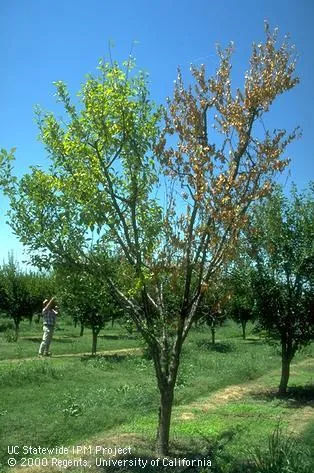
Trees are an essential part of our environment, providing oxygen, shade, habitat for wildlife, and even increasing property value. But when a tree starts showing signs of distress—such as wilting leaves, dead branches, bark peeling, or slow growth—it can be frustrating and concerning. If your tree is dying, it’s crucial to identify the cause as soon as possible to determine whether it can be saved.
There are many reasons why trees decline and die, ranging from environmental stress and poor soil conditions to pest infestations and diseases. In this guide, we will take a deep dive into the most common causes of tree decline and what you can do to prevent further damage.
1. Watering Problems: Overwatering vs. Underwatering
Water is a vital component of tree health, but both too much and too little can be harmful.
Signs of Overwatering
- Leaves turning yellow but still soft
- Wilting even when the soil is moist
- Fungus or mold growing around the base of the tree
- Soft, rotting roots
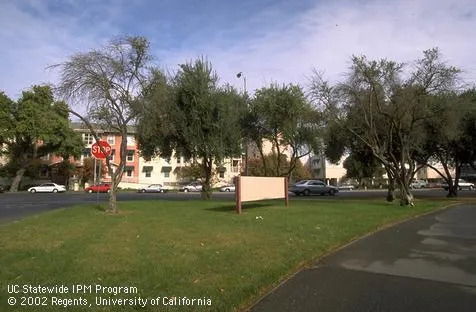
Signs of Underwatering
- Leaves turning brown and crispy
- Slow growth and thinning canopy
- Deep cracks in the soil around the roots
- Premature leaf drop
How to Water a Tree Correctly
✅ Water deeply, not frequently—Instead of light daily watering, give your tree a thorough soaking. The frequency will depend on the age, type of tree and season/climate. Here is a good guide on watering trees: Watering Landscape Trees and Shrubs: The Good and the Bad | UC Agriculture and Natural Resources
✅ Use a soaker hose or drip irrigation—These methods ensure even moisture without waterlogging the roots.
✅ Mulch around the base—A 2–4 inch layer of organic mulch helps retain moisture and regulate temperature. Mulch should not be any closer than 6 inches to the truck of the tree to avoid tree rot. Chips are preferable to shredded materials.
✅ Avoid watering directly against the trunk—This can lead to rot and fungal infections. Mulch and irrigation lines should be 6+ inches from the trunk. Water from mid-canopy to the edge of the canopy.
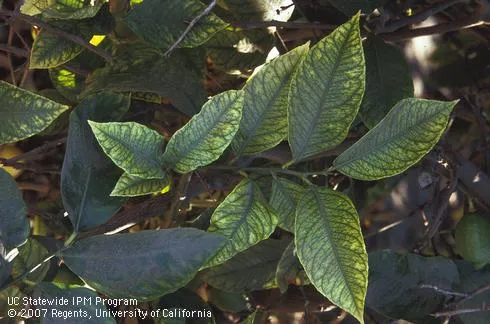
2. Poor Soil Conditions and Nutrient Deficiencies
A tree’s roots need access to essential nutrients, oxygen, and water. Compacted, depleted, or contaminated soil can stunt growth and cause decline.
Signs of Poor Soil Health
- Leaves turning yellow (iron or nitrogen deficiency)
- Stunted growth or thin canopy
- Soil that is either too dry and cracked or too wet and compacted
- Exposed roots due to erosion
How to Improve Soil for Tree Health
✅ Conduct a soil test to check pH and nutrient levels. Most trees prefer slightly acidic to neutral soil (pH 6.0–7.0).
✅ Aerate compacted soil using a pitchfork or aeration tool to improve oxygen flow.
✅ Apply organic matter such as compost or aged manure to enrich the soil.
✅ Use slow-release fertilizers based on your tree’s needs, avoiding excess nitrogen which can stress the tree. Here is an article that discusses various types of fertilizers including slow-release fertilizers: Home Gardening Fertilizing Part 1: Fertilizers 101 | UC Agriculture and Natural Resources
3. Environmental Stress and Physical Damage
Common Environmental Stressors
- Drought and Heat Stress—Leaves wilt and drop early, bark may crack
- Cold Injury and Frost Damage—Bark splits, branches turn black
- High Winds and Storms—Broken branches, uprooted trees
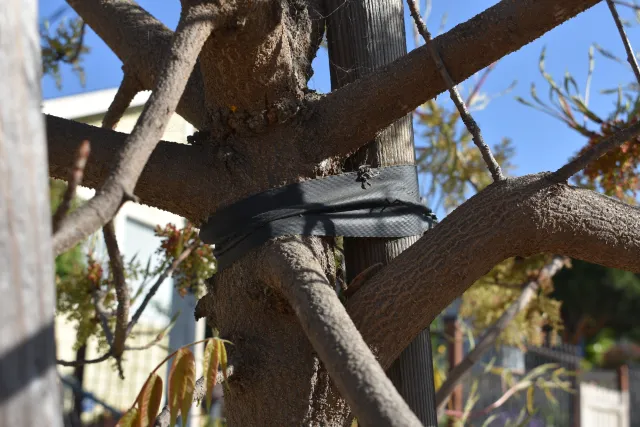
Physical Damage That Can Harm Trees
- Lawnmower and weed wacker injuries—Damage to bark can lead to infections.
- Construction and Excavation Damage—Cutting roots weakens the tree.
- Ties from Staked Tree—Damage to bark occurs if ties are not removed
- Vandalism or Animal Damage—Deer rubbing or insects boring into the trunk.
How to Protect Trees from Environmental Stress
✅ Apply mulch to insulate roots from extreme heat and cold.
✅ Protect young trees from freezing in winter by wrapping them in burlap.
✅ Stake newly planted trees to prevent wind damage.
✅ Water extra during dry spells and heat spells, especially for young trees.
✅ Prune Trees: prune trees to help maintain a good structure and improve aeration.
4. Pests and Diseases: The Silent Killers
How Insects and Pests Harm Trees
Insects can be incredibly destructive to trees. Some feed on the leaves, depriving the tree of its ability to photosynthesize, while others burrow into the bark or wood, damaging the tree's vascular system and weakening its structure. Good maintenance and proper watering, fertilizing and pruning can help trees be less susceptible to diseases. Also, as trees age, particularly trees near their natural lifespan can be more susceptible to diseases due to their weakening immune system.
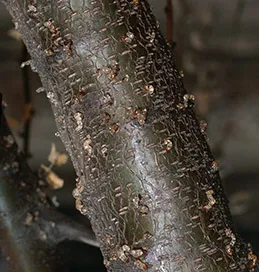
Common Tree Pests and Their Symptoms
- Bark Beetles (e.g., shothole beetles, western borer beetles, engraver beetles, etc.)
- Tiny exit holes in bark and dripping of sap.
- Sawdust-like frass (wood shavings) near the base of the tree
- Tree turns reddish-brown and dies within months
- Aphids
- Sticky residue (honeydew) on leaves and branches
- Curling or distorted leaves
- Black sooty mold growing on honeydew deposits
- Large presence of ants (attracted to the sweet honeydew)
- Emerald Ash Borer
- Metallic green wing covers and red or purple abdomen
- D-shaped holes in bark
- Thinning canopy, especially near the top
- S-shaped galleries under the bark
- Western Tent Caterpillars & Gypsy Moths
- Large silk-like tents in the branches
- Rapid defoliation in spring or summer
- Visible caterpillars feeding on leaves
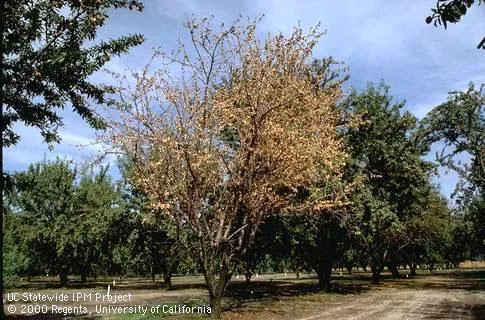
Common Tree Diseases and Their Symptoms
- Root Rot (Phytophthora, Armillaria, Pythium)
- Yellowing or wilting leaves
- Mushy or decayed roots
- Fungus or mushrooms growing at the tree’s base
- Powdery Mildew
- White powdery substance on leaves
- Leaf curling and discoloration
- Occurs in humid conditions with poor air circulation
- Dutch Elm Disease
- Wilting, yellowing, and curling leaves
- Brown streaking under the bark
- Transmitted by elm bark beetles
- Anthracnose
- Dark lesions on leaves and stems
- Premature leaf drop
- Common in sycamore, oak, and maple trees
How to Save a Tree from Pests and Disease
✅ Regularly inspect your tree for early signs of infestation or infection
✅ Prune and destroy affected branches to prevent the spread of disease
✅ Correctly identify pests and apply insecticides or biological controls using IPM principles.
✅ Improve air circulation around the tree by thinning out dense branches
✅ Encourage beneficial insects, such as ladybugs, which eat aphids
5. Root Damage: The Hidden Killer
Tree roots are essential for water and nutrient absorption. Damage to the root system can take months or even years to show visible effects.
Causes of Root Damage
- Digging and construction near the tree
- Soil compaction from heavy machinery or foot traffic
- Poor drainage leading to root rot
- Planting too deep or too shallow
Signs of Root Damage
- Wilting leaves and stunted growth
- Sudden dieback of branches
- Mushy or exposed roots
How to Prevent and Treat Root Damage
✅ Avoid heavy construction near trees
✅ Aerate compacted soil to encourage root growth
✅ Ensure proper drainage to prevent waterlogging. The crown of the tree should be above ground.
✅ Check drainage to make sure soil is draining after large storms
Final Thoughts: Can My Tree Be Saved?
A dying tree doesn’t always mean it's beyond saving. If caught early, problems such as pests, disease, and poor soil conditions can be addressed. However, if more than 50% of the tree is dead, removal may be the best option to prevent falling hazards.
If you’re unsure about your tree’s condition, consider consulting a certified arborist who can assess its health and recommend the best course of action.
With proper care and attention, your trees can continue to thrive for generations!
Additional Resources
Watering Landscape Trees and Shrubs: The Good and the Bad | UC Agriculture and Natural Resources
Home Gardening Fertilizing Part 1: Fertilizers 101 | UC Agriculture and Natural Resources
Identify and manage pests in homes, gardens, landscapes and lawns - UC Statewide IPM Program
Tree Care and Management | UC Agriculture and Natural Resources
Urban forests and trees | UC Agriculture and Natural Resources
Landscape Trees: Managing Oak Root Fungus (Armillaria) | UC Agriculture and Natural Resources
This blog post is brought to you by the Help Desk of the UC Master Gardeners of Alameda County. Subscribe to our blog!
Have a gardening question? We'll help.
Visit our Help Desk page to submit your question and see additional ways you can reach us.
